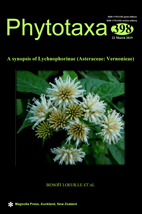Abstract
A new classification of the subtribe Lychnophorinae is proposed based on the results of phylogenetic analyses. The subtribes Centratherinae and Sipolisiinae are synonyms of Lychnophorinae and three genera (Albertinia, Blanchetia, Gorceixia) are transferred to the subtribe. As now circumscribed, Lychnophorinae comprises 19 genera and 117 species distributed mostly in the Cerrado domain of the Brazilian Central Plateau. Oiospermum is synonymized under Centratherum, and Irwinia under Blanchetia. Because Lychnophora as currently circumscribed is paraphyletic, the genus is dismantled into three monophyletic genera: Lychnophora s.s., Lychnocephalus and a new genus described herein, Lychnophorella. Seven new species are described (Chronopappus lanatus, Lychnophora grisea, L. haplopappa, Lychnophorella jacobinensis, Piptolepis riparia, Prestelia espeletoidea and Proteopsis hermogenesii), 16 new combinations are proposed (Eremanthus reticulatus, E. syncephalus, Lychnocephalus humillimus, L. mellobarretoi, L. sellowii, Lychnophora hatschbachii, Lychnophorella blanchetii, L. bishopii, L. leucodendron, L. morii, L. regis, L. santosii, L. sericea, L. triflora, Piptolepis pabstii, Prestelia purpurascens) as well as eight new synonyms. We also propose a neotype for Ampherephis pulchella, an epitype for Crantzia ovata and lectotypes for 31 names including six second-step lectotypifications (Albertinia brasiliensis, A. polycephala, Ampherephis intermedia, Centratherum fruticosum, Eremanthus leucodendron, E. purpurascens, Gorceixia decurrens, Lychnophora albertinioides, L. brunioides, L. microphylla, L. pohlii, L. reticulata, L. rosmarinus var. affinis, L. rosmarinus var. normalis, L. sellowii, Piptolepis gardneri, Proteopsis sellowii, Symblomeria baldwiniana, Vanillosmopsis albertinioides, V. glomerata, V. pohlii, V. syncephala, Vernonia burchelliana, V. ericoides, V. imbricata, V. involucrata, V. leptospermoides, V. martiana, V. platycephala, V. pseudomyrtus and V. trichocarpha).

